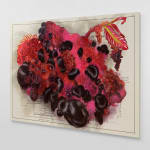-
Artworks











Fruta Fina, Fruta Estrańa (Lee Monument), 2022
Oil and acrylic on archival printed canvas88 1/4 x 111 in.
224.2 x 281.9 cm$ 325,000.00SoldFurther images
-
(View a larger image of thumbnail 1
)

-
(View a larger image of thumbnail 2
)

-
(View a larger image of thumbnail 3
)

-
(View a larger image of thumbnail 4
)

-
(View a larger image of thumbnail 5
)

-
(View a larger image of thumbnail 6
)

-
(View a larger image of thumbnail 7
)

-
(View a larger image of thumbnail 8
)

-
(View a larger image of thumbnail 9
)

-
(View a larger image of thumbnail 10
)

-
(View a larger image of thumbnail 11
)

Beneath this masterfully painted composition by Firelei Báez, the printed canvas reveals a WPA era architectural diagram for the Robert E. Lee Monument, which was built in 1884 in New...Beneath this masterfully painted composition by Firelei Báez, the printed canvas reveals a WPA era architectural diagram for the Robert E. Lee Monument, which was built in 1884 in New Orleans, Louisiana. Erected in what would later become known as “Lee” Circle, in January of 1972 the monument became a site of conflict during the violent Thompson/LaCoste confrontation between two Klansmen and the Black Panthers.
In response to the history of this site and the violent acts that took place there, Báez conjures a counter-monument to survival. The glistening fruit and flora exquisitely rendered in this painting, as well as the title of the work -- Fruta Fina, Fruta Estrańa (Lee Monument) -- reference Abel Meeropol’s haunting poem “Strange Fruit”, later popularized by Billie Holiday. In this painting, In this painting, as a counter to these fraught histories, Báez hones in on the lushness of the body, not in a didactic or anthropological sense, but as a form and a signifier. Here, the body is re-imagined as a glimmering, yet slightly surrealist, mass of life; a cell-like structure, infinitely multiplying, broken down to its most basic and life-affirming parts.
Exhibitions
James Cohan Tribeca, Americananana, October 27 – December 21, 2022
Firelei Báez: Trust Memory Over History, Louisiana Museum of Modern Art, Denmark, October 5, 2023 - February 18, 2024 -
(View a larger image of thumbnail 1
)










